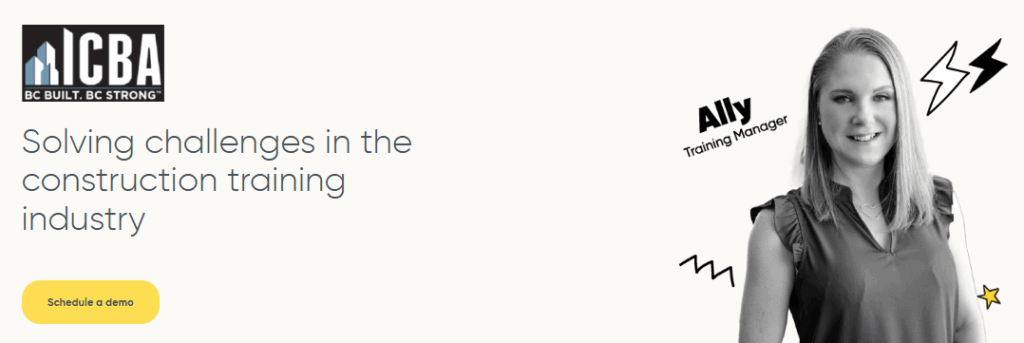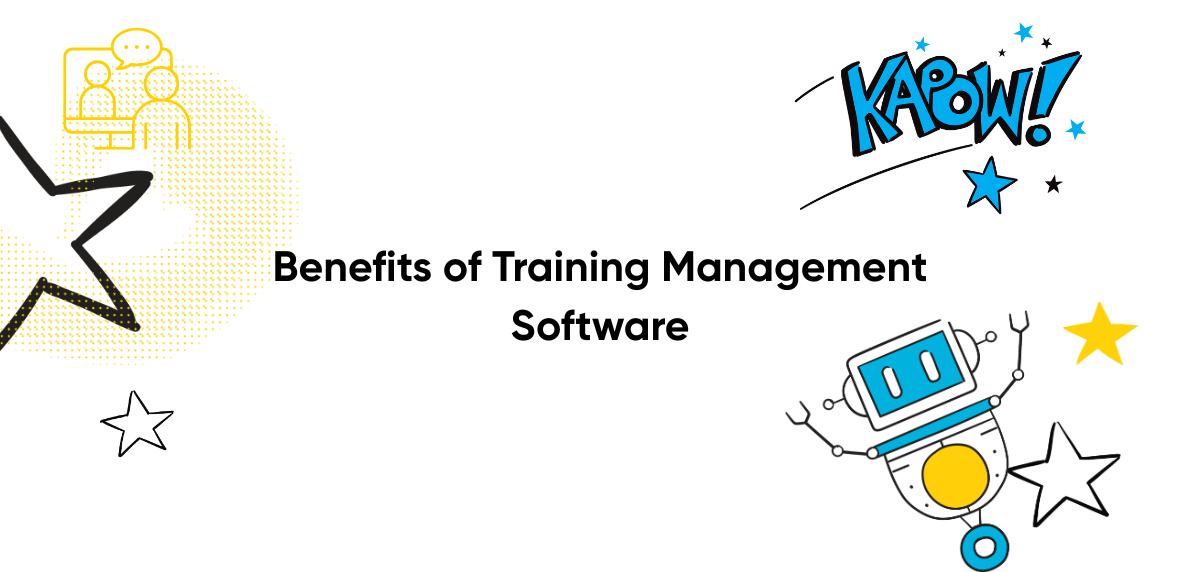Training management software and systems are the central hub for successful training businesses. Through them, they can:
- Create and schedule courses
Set up course sessions, manage recurring schedules, and assign presenters. - Manage presenter availability
Track instructor calendars, avoid conflicts, and allocate resources efficiently. - Set up course logistical requirements
Coordinate venues, equipment, online meeting links, catering, and other operational needs. - Take and process registrations
Handle online registration, waitlists, cancellations, and online payments. - Send communications
Automate confirmations, reminders, follow-ups, and course-related email/SMS notifications. - Report on key metrics
Use built-in reporting tools to track attendance, course completion, revenue, and other indicators of training performance.
All of these processes bring various benefits to training providers which we cover in this blog post. For each one, we explain what it looks like in practice and share a real-world example of how Arlo has helped a training business achieve that specific outcome.
Let’s jump in 👇
1. Provide Better Training
Perhaps the biggest benefit to training providers that training management software brings to training providers is that it allows them to to deliver more consistent, organized and accessible training by managing the logistics around training scheduling, presenter coordination, session formats and registrations.
A TMS ensures that structured, well-designed training courses are delivered reliably and at scale, especially when a training provider is looking to combine formats like online, in-person and blended learning.
How Arlo Helped Taye Training Deliver Better Training
Arlo helped Taye Training, UK-based learning and development training provider streamline and automate many of their manual training processes.

Before Arlo, the company were managing their training processes manually:
- Staff created Zoom links manually and emailed them individually to delegates and facilitators.
- Registrations, attendance, and reminders were tracked in spreadsheets.
- Certificates were issued one at a time after each session.
- Evaluation surveys were sent using standalone tools, with no integration or automation.
- Admin tasks were duplicated across systems and took hours per course to complete.
When the pandemic forced all training online, the workload became unmanageable, leaving no time to focus on improving delivery or learner experience, which lead to the company discovering and implementing Arlo.
After adopting Arlo:
- Course setup, Zoom scheduling, joining instructions, reminders, and follow-ups were automated.
- Attendance was captured directly from Zoom and synced with learner records.
- Certificates and post-course surveys were issued without manual effort.
- Admin time per course dropped from hours to minutes.
- The team refocused on facilitator support, content improvement, and scaling delivery.
The Result:
Taye grew the company 4× and now trains thousands more delegates across the UK. Freed from day-to-day admin, the team was able to pursue national tenders, expand subject offerings, and deliver consistent, values-led training at scale, without compromising on learner experience or training quality.
2. Sell More Courses and Increase Registrations
A training management system helps training providers increase course sales by connecting course creation, marketing, and registration into a single streamline workflow.
Instead of manually publishing courses, tracking leads, sending emails, and managing sign-ups across multiple platforms, everything is coordinated through one system.
Here’s how it works:
Course setup is fast and repeatable: Training providers can create a course once and reuse templates to quickly schedule new sessions. This speed up publishing and keeps offerings fresh, which is especially important for high-frequency or recurring training.
Course pages are automatically generated: When a new course is scheduled, the system publishes an up-to-date with session details, pricing, dates, availability, and an embedded registration form, no need for web developers or duplicate data entry.
Lead capture and nurturing tools are built in: For on course pages capture enquires and email addresses, automatically adding them to the CRM. Automated workflows can follow up with leads who don’t convert right away, via reminder emails, offers, or course suggestions.
Registrations are tracked in real-time: As learners sign up, the system logs key details: session, contact, info, payment status, marketing source, and more. This allows training teams to monitor and report on sales performance quickly and easily.
Marketing and sales data are connected: Providers can see which campaigns or channels are generating registrations and adjust strategy accordingly. For example, they can target a discount to people who viewed a course but didn’t register.
Checkout is seamless and reliable: With built-in or integrated payment processing, learners can register and pay in one step, minimizing friction and reducing abandonment.
How Arlo Helped International TEFL Academy Sell More Courses and Increase Registrations
Arlo helped International TEFL Academy scale their revenue and increase course registrations by transforming their sales process from a fragmented, high-friction experience into a seamless, self service model.
Through strategic integrations, checkout optimization, and expert guidance from Arlo’s Professional Services team, ITA turned their training website into a revenue-generating engine—with automation, upsell paths, and real-time data built in.

Before Arlo:
- Fragmented systems: ITA’s ecommerce platform, CRM (Salesforce), LMS (Moodle), and website were siloed, requiring manual data syncing and limiting visibility.
- Manual checkout: Customers often had to go through ITA’s traditional sales process, creating unnecessary steps between discovery and enrolment.
- Basic ecommerce tools: Their existing shopping cart lacked bundling, upsell logic, and automation features.
- Missed conversion opportunities: No automation for abandoned carts, no referral tools, and limited ability to promote offers or discounts at scale.
- Slow marketing execution: Changes to course pages or pricing often required manual intervention, slowing time-to-market.
After implementing Arlo:
- Streamlined checkout and self-service: Arlo’s web controls integrated directly into ITA’s HubSpot website. This reduced internal effort and improved the user journey. Customers could register and pay instantly.
- Bundled course sales: Using Arlo’s bundling features, ITA packaged related courses together to increase average order value and customer retention.
- Abandoned cart automation: Arlo was integrated with HubSpot to trigger automated emails when users dropped out of checkout. This brought over 50 customers per month back to complete their bookings.
- Payment optimization: ITA used checkout customization to recover credit card processing fees by passing them to customers transparently.
- Referral program: Customers could instantly share a referral link from their order confirmation page, making it easy to refer friends and drive additional sales.
- Marketing agility: With Arlo as the central system, the team could quickly launch campaigns, adjust pricing, and refine their offerings with greater confidence.
The Result
- +236% increase in self-service online checkout sales within the first month after switching to Arlo.
- +340% increase in bundled product purchases, along with a higher average revenue per customer.
- 50+ monthly course sales driven by abandoned cart email automation.
- Reduced manual sales involvement, which allowed the team to focus on strategic growth.
- A referral program that generated $1,550 for one customer, with significantly more revenue earned for ITA overall.
3. Deliver Flexible Training Delivery Across Formats
A training management system gives providers the flexibility to offer training in multiple formats – face to face, live online, on-demand, self-paced, or blended, without creating a ton of operational overhead.
Instead of managing each format in a different system or duplicating effort across platforms, a TMS provides a unified backend to coordinate sessions, presenters, registrations, communications, and attendance across all training delivery types.
This flexibility allows providers to:
- Offer the same course in multiple formats to suit different learner preferences
- Run in-person and virtual sessions side by side without confusion or data loss
- Build blended learning journeys by combining live sessions with self-paced components
- Adjust quickly when circumstances require switching delivery methods (e.g. moving in-person events online)
- Track learner progress and attendance across all formats in one place
The result is a smoother experience for both administrators and learners, with more options to match different training needs and contexts.
How ICBA Scaled In-Person and Live Online Training Across Canada
Canada-based Independent Contractors and Business Association (ICBA) trains over 6,000 people annually in a wide range of technical, safety, and leadership skills for the construction sector.

When the pandemic forced them to move all their face-to-face training online, they needed a platform that could support this shift and still scale their growing national reach, which lead them to Arlo.
Before Arlo:
- Training programs and courses were tracked using spreadsheets, with no automated confirmation or follow-up.
- Switching to online delivery created even more admin, including manual Zoom setup and communications.
- There was no integrated CRM, no self-service for learners, and no way to manage multiple formats at scale.
- Manual certificate handling and poor visibility slowed down operations.
After Implementing Arlo:
- Courses could be delivered in-person or live online, with Zoom sessions automatically created and linked to registrants.
- Automated emails handled confirmations, reminders, updates, and certificates.
- Learners accessed course info, documents, and certificates through a branded self-service portal.
- ICBA could filter and publish courses across regions and formats with ease.
- The built-in CRM gave the team a complete view of each customer’s training history, activity, and certification timeline.
The Result:
- ICBA delivered more than 850 courses in a single year across multiple provinces.
- The team significantly reduced admin overhead while increasing delivery volume.
- Training quality and learner experience remained consistent, regardless of format.
4. Reduce Administration and Eliminate Repetitive Tasks
Something we’ve already touched upon, but it’s with its own point. Manual administration is one of the biggest bottlenecks in running a training business.
And it’s something that not only costs a training provider time, but also lost revenue, staff frustration, and ultimately leads to the delivery of ineffective training.
Coordinating course logistics, updating spreadsheets, chasing payments, sending reminders, and issuing certificates all take time,and often need to be repeated for every course or registrant.
A training management system centralizes and automates these repetitive processes so that staff can shift focus from admin to value-adding activities like improving course content, supporting facilitators, or expanding reach.
Here’s how a TMS helps reduce training admin:
- Automates key workflows like confirmations, reminders, and feedback requests
- Automatically syncs data across systems (CRM, LMS, calendar, finance)
- Eliminates double entry and spreadsheet dependency
- Centralizes communication history, course data, and learner records
- Reduces errors and delays from manual oversight.
How cLearn Reclaimed 30 Hours a Week by Automating Admin with Arlo
Based in North Carolina, cLearn delivers continuing education and certification training for the construction industry through hundreds of live webinars each year.

As the business grew, managing training manually became unmanageable, which led to cLearn discovering and implementing Arlo’s training management system.
Before Arlo:
- The founder manually managed all training logistics—including registrations, Zoom setup, follow-ups, and certificates.
- Each participant had to be emailed individually, increasing the risk of missed or incorrect details.
- State-mandated certificates were created and sent manually, taking hours every week.
- There was no central system to track attendance, learner history, or compliance requirements.
- Website updates for new courses were done manually, slowing down publishing and adding complexity.
After Implementing Arlo:
- Learners registered online and instantly received confirmation emails, Zoom links, calendar invites, and waitlist notifications—automatically.
- State certificates were automatically generated and emailed upon course completion.
- Reminder emails and post-course follow-ups were fully automated, reducing no-shows and boosting engagement across the entire training business.
- The in-built CRM tracked every learner’s history, attendance, and certification data—supporting compliance without added admin effort.
- New courses could be published in minutes, with automatic updates to the website and fully branded learner experiences.
The Result:
- cLearn saved up to 30 hours per week on admin tasks, the equivalent of a full-time hire.
- The business scaled rapidly, expanding its course offerings, building a consulting arm, and launching a second course catalogue.
- The team maintained quality and compliance while increasing course volume, without increasing headcount.
Final Thoughts and Other Training Management Software Resources to Check Out
There you have it! 4 key training management software benefits a TMS brings to a training provider:
✅ Delivering better, more consistent training
✅ Increasing course registrations and revenue
✅ Offering flexible training delivery across formats
✅ Reducing admin workload and eliminating repetitive tasks
If you’re evaluating a training management system, these examples show what providers are actually achieving.
More course sales. Faster setup and delivery. Less time wasted on admin. And the ability to offer better training without needing more staff.
If you want to learn more about what training management software is, and what it can bring to your training business – check out our Ultimate Guide to Training Management Systems.
Alternatively, if you want to try the #1 training management software helping thousands of training providers across 70+ countries scale their business and deliver better training, start a free trial of Arlo below 👇
